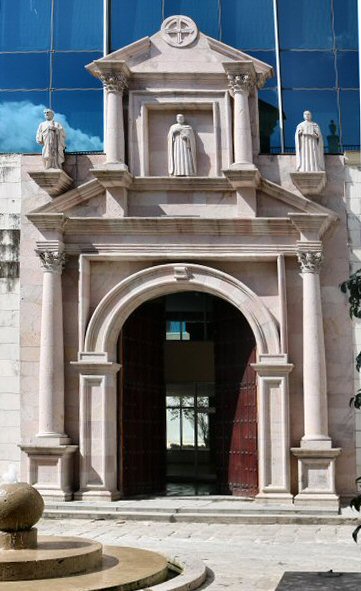

In 1845, when the Obispo street was
expanded to solve the traffic problem, the facade of the convent
lost all of its beautiful decoration. The building became first
the depository of the Real Cuerpo de Ingenieros; then the
Instituto de Segunda Enseňanza de La Habana was inaugurated in
the southern part of the building in 1863. José Martí is one of
the students of this institute. Later, in 1876, a pawnshop,
Monte de Piedad, and the first police station occupied some
rooms of the building, and in 1887 it became the seat of the
Loma de la Pirotecnia Militar. In 1902, when the University of
Havana moved to the Aróstegui hill in the Vedado district of
Havana, some faculties remained in the building of the old
convent.
After the revolution in 1959,
first the Ministry of Estates, then the Ministry of Education
occupied the building, the latter staying here until 1990s.
CURRENT BUILDING
In 2000 the Office of the Historian of the City of Havana decided to recreate the vanished image of the old convent. The massive concrete structure was surrounded by a glass envelope. One of the cloisters was restored and converted into the symbolic “patio of the laurels” of the first Cuban university. The space of the main nave was rescued, and its auditorium function was reassigned. The splendid baroque doorway on the Mercaderes street was reinterpreted by the stones from Michoacán quarries in Mexico. The campanile that contains the original bell is restored.
There are four statues standing in line in front of the building in the Plazuela de Santo Domingo on the Mercaderes street. They belong to the Portuguese poet Luiz Vaz de Camóes, the British writer William Shakespeare, the Spanish writer Miguel de Cervantes y Saavedra and the Italian thinker and writer Dante Alighieri respectively.
Shakespeare is
represented as talking to a skull in his hand like in Hamlet:
”to be or not to be”. The statue of Cervantes is unveiled in
2017 and it is the work of the Cuban sculptor José Villa Soberón.
The writer is represented standing. He is slightly leaning on
his right leg and writing something with his quill pen. From his
waist hangs a sword, referring to his life as a soldier
THE MUSEO DE LA UNIVERSITAD
The building today houses the Museo de la Universidad (Tuesday-Saturday 09:30-17:00, Sunday 09:30-13:00) that displays miscellaneous objects, related to the early period of the university. The entrance is on the O’Reilly street. Basically, it consists of two exhibition rooms. In the first room you will see a model of the building. Some details about the model are given on panels. The second important object in this first room is the statue of Virgen de las Nieves (Virgin of Snow). Virgen de las Nieves is an ancient Marian invocation that dates back to the fourth century and is widespread in Italy, Spain, Latin America and Portugal. The limestone statue was made in Cuba in the 17th century and belonged to the Convento de San Juan de Letrán.
In the second exhibition room, you will
find the statue of Santo Domingo, represented during his pray to
God. The polychrome wooden statue was carved in Spain in the
18th century. Some pages from singing books, printed on leather
or parchment, are exhibited in showcases. They all are printed
in Spain in the 18th century and belonged to the Order of Santo
Domingo. More interesting are the minutes of the Town Hall (cabildo)
in 1688. Finally, you will see the gravestone of a military
engineer and his wife, written in Catalan language.
Since 2003 it is occupied by the
Colegio Universitario San Gerónimo de La Habana, and The
Dominican friars are transferred to the new church in Vedado,
the Convento de San Juan de Létran.